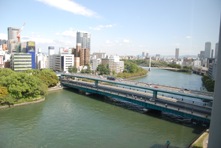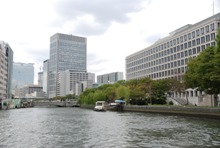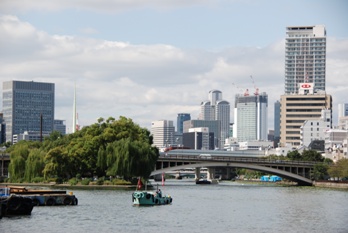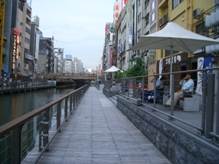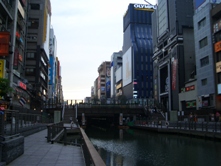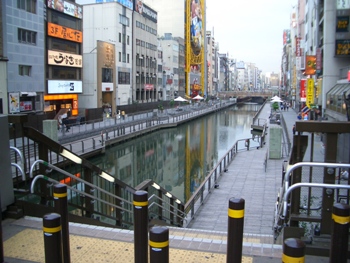
< World's WATERFRONT:JAPAN Category: Kinki >
|
Photo by Akira WADA, Oct.. 2007
|
Along Oh River (previously called Yodo River), improvement of city parks, water bank protection, and docks has been carried out toward the creation of an urban environment having an affinity for water. In Osaka Amenity Park, in particular, a waterfront space appropriate to the lagoon city of Osaka is provided based on the concept of “creation of a complex city space well equipped with amenities and full of water, greenery, and light.”
By JRRN-secre | Category: Community and urban river restoration,Kinki | Comment(0) | Trackback(0) |
Date: 2012.01.05 16:16
|
Photo by Masafumi Ito, June 2006
|
For Dotonbori River or the river representing Osaka, the walking trail has been improved as part of a project to regenerate “the lagoon city of Osaka,” by which people can feel familiar with water. By improving the flood gates that have the functions of water purification, tide prevention, and lockage, waterfront environmental improvement in the peripheral areas has been achieved.
By JRRN-secre | Category: Community and urban river restoration,Kinki | Comment(0) | Trackback(0) |
Date: 2012.01.05 16:15
When Hidetsugu Toyotomi opened a castle town at the base of Mt. Hachiman, the "Hachiman Moat" running through Omihachiman City was built as a canal to allow barges running in Biwa Lake, which was the artery at the time, call into Hachiman.
Due to the rapid urban development after the war, the water environment of Hachiman River was deteriorated and in the decade starting in 1965, a land reclamation plan was embodied. However, activities toward dredging and regeneration of the moat were started mainly by citizen groups who considered the moat to be historical heritage from their ancestors. Such activities are continued even today to maintain the landscape of the moat and improve the water quality by the "Citizens' Association to Protect Hachiman Moat."
Although transportation by ship has ended, ships are still used by tourists in imitation of the traditional elegant boating of the Imperial Court. Today this has become a special feature of sightseeing tours and 280,000 people visit this area yearly. Hachiman River was designated as one of the best 100 revived waters in Japan.
By JRRN-secre | Category: History and traditional restoration,Navigation restoration,Kinki | Comment(0) | Trackback(0) |
Date: 2011.09.10 18:29
Nishitakase River running through Kyoto City was opened as a canal for transportation by water. Later, it was used to discharge the water for textile dyeing such as Kyo Yuzen printing and the color of the river water changed daily and the water quality deterioration was serious.
Under the circumstances, the contamination was reduced and ozone treatment facilities were installed in 1997.Since then the color of the river and foam formation have been improved dramatically and the water environment of this river has greatly recovered. In addition, this river was selected as a "Limpid Stream Renaissance II project river" and because efforts were made to create an environment for water amenities and improve the water quality, a river environment suitable for a stroll in Kyoto has been recovered.
By JRRN-secre | Category: Water quality Restoration,Kinki | Comment(0) | Trackback(0) |
Date: 2011.09.10 18:23
In Yodo River running through Osaka, earth and sand are deposited around the spur dike, which was built to maintain the course for cargo ships, and many pools and valuable habitats for organisms have been created. However, because the water level fluctuation has decreased as a result of the construction of Yodo River Great Weir downstream, its environmental impact on Johoku pools is a concern.
For this reason, an experiment toward the recovery of the pool environment is being conducted by improving the operation of the weir to increase the water level fluctuation and improve the in-pool water quality.
By JRRN-secre | Category: Nature oriented restoration,Navigation restoration,Kinki | Comment(0) | Trackback(0) |
Date: 2011.09.10 18:09
In the area of Kita River running through Fukui Prefecture, great damage was caused over large areas by the season’s 19th typhoon in 1997. With this disaster as a trigger, Japan’s first special emergency project for countermeasures against serious river disasters was adopted and drastic river improvement work has been conducted since then.
To conduct this emergency project, the “Kita River Rehabilitation Exploratory Committee” consisting of experts, local representatives and organizations concerned was established and measures are being taken to secure the continuity of the riffles and pools and properly cut and conserve trees by generating a natural waterside.
In 1994, these efforts were designated as “a model project to promote the creation of a river up which fish can easily swim”. From the viewpoint of securing the vertical continuity of the river, a project to regenerate the habitat for aquatic life is being conducted by creating riffles and pools by utilizing the sediment movement by natural power rather than by artificially digging the riverbed.
By JRRN-secre | Category: Nature oriented restoration,Kinki | Comment(0) | Trackback(0) |
Date: 2011.09.10 18:05
Ibo River in Hyogo Prefecture flowing into Seto Inland Sea had a poor record: it was designated as the 3rd- to 5th-worst river in Japan in terms of water quality because the wastewater was discharged from households and the local industries such as leather product makers.
Under the circumstances, construction of a sewage system was promoted in the Ibo River Basin and the sewage system penetration rate was improved. In addition, the whole quantity of the leather makers' wastewater has been accepted by the water treatment facilities since 1994. As a result, Ibo River made rapid progress in recovery and gained the 2nd-best place in water quality in the Kinki region in the following year. It was also designated as one of the "100 revived waters". Today, the ascent of natural plecoglossus altivelis was observed for the first time in 40 years and the recovery of a clean stream of Ibo River was welcomed by local people. A fishing contest and river-rafting held by a local group is becoming popular year by year and the connection between the local community and the river has been revived.
By JRRN-secre | Category: Water quality Restoration,Kinki | Comment(0) | Trackback(0) |
Date: 2010.09.10 18:24
In Maruyama River Basin, the natural habitat was changed by agricultural land improvement, forest development and housing land development. In particular, ciconia boyciana have vanished in this area since 1971.
Today, ciconia boyciana (whose wild species are now extinct in Japan) is bred artificially in the prefectural “Ciconia boyciana Home Park” located in Toyooka City for release into the wild. As part of the environmental improvement measures to allow ciconia boyciana and various living organisms as a food source for ciconia boyciana, a river and waterfront environmental regeneration project is also being conducted.
By JRRN-secre | Category: Nature oriented restoration,Kinki | Comment(0) | Trackback(0) |
Date: 2010.09.10 18:10
Inland lakes have diversified functions represented by natural ecosystem maintenance and water quality improvement. Hayazaki Inland Lake, which contacts Biwa Lake, was once the largest spawning ground of endemic carassius cuvieri in Biwa Lake, where precious plants including vallisneria natans and brambles were grown and aquatic birds such as tachybaptus ruficollis and resident birds lived. However, the area has been shrunk by agricultural land reclamation. Also the disappearing waterfront ecotone due to the construction of the dike on the lakeside is affecting the growth of various indigenous organisms.
For this reason, Hayazaki Inland Lake Restoration Project was inaugurated as a leading-edge project to conserve the Biwa Lake ecosystem. Since 2001, regeneration of the inland lake by flooding an area of 17 ha out of the 89 ha reclaimed agricultural land has been studied.
By JRRN-secre | Category: Bay and lake restoration,Kinki | Comment(0) | Trackback(0) |
Date: 2010.09.10 18:08
